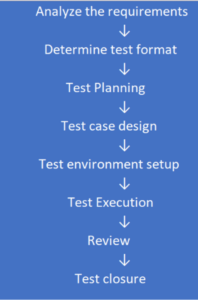

Introduction to test design
Building a foundation for reliable and maintainable products transcends just writing code. It involves investing in the long-term health and success of your software project. Ensuring a flawless user experience, building confidence, anticipating challenges, and ultimately bringing a vision to life are crucial. The American professor of software engineering, Cem Kaner, succinctly captures it: “The best tester isn’t the one who finds the most bugs or who embarrasses the most programmers. The best tester is the one who gets the most bugs fixed.” Hence, there’s a need to have a system in place to test your software project. This system is called “test design,” which allows for creating tests that verify software applications.
In this post, you’ll learn about a test design, what it is, and why it’s important to have a good test design. Furthermore, we’ll examine the details of types of design techniques or concepts, as well as steps and processes to design effective tests. Additionally, we’ll look into the challenges of test design and some best practices for addressing those challenges.
Let’s get started!
What is test design?
Test design is the process of creating a strategic plan for test cases, scenarios, and conditions to ensure it meets the performance and reliability of software or systems. It aims to ensure test cases effectively uncover software defects and behave as expected under various conditions. An American computer scientist, entrepreneur, and author, Glenford Myers, has this to say about test design: ”Good test design anticipates potential failure modes and explores system boundaries.”
Elements of test design
Some key elements of test design are:
Test Objectives: Define what you intend to achieve with the testing. Aim to verify system functionality, usability, security, and other aspects of the software.
Test Cases: Describe instructions for executing a test. The test can include the ID, summary, steps, and test environment.
Test Scenarios: Describe what to test to ensure you test the software from an end-to-end perspective and cover user paths.
Test Data: Ensure the data used for executing test cases covers various scenarios and test conditions. The data can be valid, invalid, or boundary value data.
Test Design Techniques: Identify the methods used to create test cases to achieve maximum coverage.
Test Plan: Create a comprehensive document showing the testing approach, objectives, scope, and criteria for success.
Importance of test design
Test design is a key concept in the software testing process and quality assurance. It’s key to achieving high quality by systematically evaluating and validating if the software meets its intended requirements and functions correctly.
Some of the importance of test design to software testing processes are:
- Efficiency: Well-designed tests focus on critical areas, which saves time and resources.
- Prompt Issue Identification: Effective test design reduces the cost of fixing issues by uncovering defects early in the development process.
- Quality: Extensive testing improves user satisfaction and software quality.
- Improve Communication: Sharing detailed test cases with team members provides a clear framework and documentation, improving communication and understanding.
- Risk Mitigation: Test designs prevent costly failures by uncovering potential issues.
Test design techniques and concepts
Test design concepts are methodologies employed to create effective test cases for comprehensive software testing. They help identify potential defects that need improvement. Here are some of the common types of test design techniques, which can be broadly grouped into six main types:
- Black-box testing techniques
- Experience-based testing techniques
- White-box testing techniques
- Pairwise techniques
- Model-based techniques
- Orthogonal array testing
Test design concepts are methodologies employed to create effective test cases for comprehensive software testing. They help identify potential defects that need improvement.
Black-box testing
Black-box techniques are based on the software’s external, and not internal, behavior.
- Equivalence partitioning: Testers divide inputs into equivalent partitions.
- Decision-table testing: Use a tabular format to represent complex decision logic and test cases, ensuring all possible conditions are tested.
- Boundary-value analysis: Test values at the boundaries of both input and output ranges. Many errors occur at the edges of these ranges.
- Use-case testing: Test the system based on user interaction and scenarios.
- State-transition testing: Test the different states as a finite state machine and design test cases based on the transitions.
Experience-based testing
These techniques rely on the tester’s experience, knowledge, and intuition.
- Error guessing: Testers design test cases based on their knowledge and experience. The testers predict areas likely to contain errors and design test cases accordingly.
- Exploratory testing: Testers use their knowledge and intuition to explore the application without known test cases.
White-Box testing
White-box techniques examine the internal structure of the software.
- Statement coverage: Ensure statements in the code are executed at least once.
- Branch coverage: Ensure the branches of decision points are executed at least once.
- Condition coverage: Ensures that decision point conditions are tested for true and false outcomes.
- Path coverage: Ensures every possible path through the code is executed at least once.
Pairwise testing
Pairwise techniques are based on testing all possible combinations of input parameters.
Model-based testing
The model-based technique represents the system’s behavior, states, input, and output. It also leverages models to design, automate, and execute test cases.
Orthogonal array testing
The orthogonal technique uses an orthogonal array to select a subset of test cases from pools of inputs.
How to design effective tests
Designing effective test designs is crucial for ensuring software quality. It involves steps that ensure tests are reliable, valid, and comprehensive.
Some of the processes are as follows:
- Analyze the requirements: It’s essential to determine what you intend to achieve with the test by understanding the system’s requirements. Understanding the functional and non-functional requirements forms the basis for designing effective test cases.
- Determine the test format: Decide on the number, types of questions, and the time allotted for the test.
- Test planning: Create a testing scope and strategy outlining approaches, features, functionalities, resources, and scheduling.
- Test case design: Use various test techniques, like boundary-value analysis and decision tables, to prioritize test cases based on risk and impact.
- Test environment setup: Hardware, software, and data needed for testing should be available.
- Test execution: Execute and record test results to confirm if they are according to plan.
- Review: Administer the test to the target audience to identify issues. Therefore, it’ll allow you to make the necessary changes based on the feedback.
- Test closure: Generate reports and metrics based on the test results.

Challenges associated with test design
Test design is crucial in the software development life cycle. Despite its importance, it comes with some unique challenges. Some of the challenges are as follows:
- Defining clear objectives: Requirements can lack necessary details, which makes it difficult to design effective test cases. The frequent changes in requirements made by updating test cases also impact test design.
- Test case design complexity: Creating test environments to mimic production conditions is error-prone and complex. Creating diverse test data is resource-intensive and time-consuming.
- Test coverage: It isn’t easy to ensure all software functionalities are adequately tested, especially for large-scale applications. The process of determining areas to test can be challenging.
- Technical issues: There can be difficulties in ensuring tests work on various components, and existing tools might not support some test scenarios.
- Resource constraints: Due to the company’s financial status, inadequate testing tools can hinder test case development.
- Automation: Determining the best automation tool for specific testing can be challenging. Choosing the right test cases suitable for automation can be complex.
- Risk management: Recognizing potential harmful risks that could impact test design is time-consuming.
- Test data management: Creating, maintaining, and securing appropriate test data is challenging.
How to approach test design challenges
Some of the best practices to navigate common test design challenges are:
- Have a clear understanding of the objectives and requirements.
- Gather diverse perspectives by engaging developers and business analysts early in the test design phase.
- Adopt a more robust and structured approach, like decision-table testing or equivalence partitioning, to create comprehensive test cases.
- Prioritize test cases based on their importance and impact.
- Create a reusable library of common functions that works across different tests.
Summary
This detailed guide explored the importance of test design, outlining various design techniques and steps to create effective tests. We also examined common test design challenges and potential solutions. Tricentis is a great starting place for unlocking test design, testing, and continuous performance.
This post was written by Kamaldeen Lawal. Kamaldeen is a frontend JavaScript developer that loves writing a detailed guide for developers in his free time. He loves to share knowledge about his transition from mechanical engineering to software development to encourage people who love software development and don’t know where to begin.